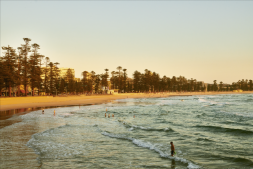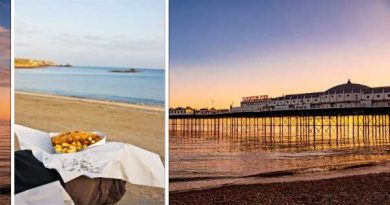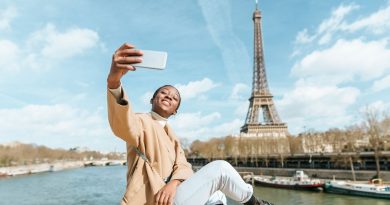In Manly, Australia, Love for the Surf Goes Deep
There’s something almost religious about the start of the Bold and Beautiful swim, from the Manly Life Saving Club to Shelley Beach, about half a mile around the rocky coast, and back again. Every morning at seven o’clock, a hundred or so people of all ages wade into the water in bright pink swim caps and Speedos, like budgie-smuggler Baptists. At a distance they resemble the cast-iron figures of British sculptor Antony Gormley, barely distinguishable from one another, looking to the water for answers.
My sister lives in Manly, a beachy suburb on a peninsula at the southern end of Sydney’s Northern Beaches. I’ve been coming for 20 years, doing the odd Bold and Beautiful swim since it started with five people on Boxing Day in 2008. Today, more than 17,000 people in total have done the swim, and Manly has become a different place—one of Ulla Johnson dresses and wryly branded Asian-fusion restaurants. But its soul has always resided in the ocean: off the quiet beach on the harbor side, where the recognizable green-and-mustard ferry heads into Sydney past the little bays of the North Head, and off the beach on the Pacific side, where surfers dash into the sea and “nippers”—young members of Australia’s surf-lifesaver clubs—paddle out on kneeboards like frantic, happy insects.
Every day the ocean here is different. When the sky is flat, the Bold and Beautiful swim is a languid float above schools of translucent little yellowtail, the odd dopey blue groper, and an occasional flapping manta ray. Paddleboarders head to catch swells out at the becalmed point, and longboarders cruise on glassy little rollers. On big days, though, a swim feels like being a cork on a Shakespearean tide, the sea life sheltering beneath the roiling sediment. As the surf rises, the surf lifesavers’ intonation over the loudspeakers shifts from languid to urgent.
There’s a new 50-mile walk from Manly to Bondi Beach, to the south of the harbor, really a joining-up of a series of existing harborside meanders. Bondi and Manly both claim to be the birthplace of the surf-lifesaving movement, in the early 20th century—a voluntary community focused on safety, rescue, and education that, in classic Australian style, morphed into a competitive sport. They are the most iconic beaches in a city full of them. So it makes sense that the epic walk between them is an ever-shifting waterscape: Between Manly and the Spit Bridge, deserted bays recall Greek islands; at Rose Bay, seaplanes arrive for long, wine-fuzzed lunches at Catalina, where pelicans with huge cartoon eyes ogle sweet Sydney rock oysters. Glassy cuboid properties look to the water, some with paths leading down to private jetties in the harbor. And yet, for all the growing wealth in Sydney, the ocean remains a democratic space, one with room for paddleboarders with Great Danes; for kids jumping from cliffs or floating lumps of Styrofoam; for helmeted men on whizzy new electric hydrofoil boards, like Silver Surfers.
But the attachment to the ocean runs deeper than jolly recreation. I recently met up with 48-year-old Layne Beachley, the radiant seven-time world surf champion from Manly. For her, surfing began as both a channel for her ambition and a form of therapy to make sense of the death of her adoptive mother when she was six, which left her feeling “abandoned, worthless, unloved.” Beachley describes the water as “my place of solace: the love of my life, where I rinse off my suffering and feel truly connected to my soul.” Only when she won her sixth world title, having fought for every wave in an unrelentingly macho space, did she think, Okay, I’m enough now. But she still needs the water, just like her 81-year-old adoptive father, Neil, a surf-lifesaving pioneer who still gets up at 4:30 every morning to walk the length of the beach alone.
I have heard about the humbling, healing power of waves from other Manly surfers, who seem like anonymous black-clad figures in the water, wordlessly paddling out when a big swell rolls in. And, on the Bold and Beautiful swim, I often wonder what is going on in the heads of my fellow swimmers as we scythe through the water in our curious pink shoal. Are they thinking of loves and losses? Of family or footy scores? Watching for signs of life under the water? Or simply counting strokes, trying to ignore aching shoulders? Whatever the case, despite the occasional kick in the face and gulp of salty water, it feels like a safe space. At the end, we stumble back onto terra firma, ripping off our lurid hats, buzzed and faintly goose bumped. We are human again, but now we are cleansed.
Where to get a feel for Manly
Manly is packed with shops selling the wave rider’s dream, but Aloha Manly is the surfer’s surf shop. Launched in 1991 by a team including world champion Dooma Hardman and iconic shaper Greg Clough, for most of the past two decades it’s been owned by chatty original store manager Tim Hanrahan, who claims to have gripped more boards than anyone on earth. While there are often sponsored surfers browsing boards made by Manly and brands like Firewire and Lost, hacks are welcome too.
Manly’s beaches have very different vibes, from the still waters and jumping postwork wharf bars on the ferry side to the wave crash and lifeguard din on the ocean side. Shelley Beach is a secluded bay for snorkelers and bush hikers heading for Shelley Head. This gentle mini scene is served by The Boathouse, an outpost of the whitewash-and-driftwood casual dining chain that has become synonymous with Sydney’s Northern Beaches. Just up the walkway, The Bower café does ceviche and great coffees and overlooks the Fairy Bower ocean pool, built into the rocks.
Rollers Bakehouse, a bakery and L.A.-style café, has become Manly’s top postsurf hangout since opening on a forgotten side street in 2018. Surfers fresh from big days at Deadman’s break come for self-taught baker James Sideris’s exquisitely flaky croissants, displayed on a street-facing counter, and coffee from cofounder Bo Hinzack’s Okay Coffee roastery in neighboring Brookvale.
Sunset Sabi is the buzziest spot in town, with brick walls covered in kitsch Japanese signs and irreverent takes on sushi and Japanese comfort food—like the Double Double Gyoza, which tastes happily like a Big Mac. Luke Miller runs the coolly minimalist Italian restaurant Busta, just down Pittwater Road; he’s also a partner in Winona Wine, a super-hip organic wine shop a few doors down. Manly is that kind of place.
Of Manly’s excellent seafood restaurants, the Herring Room on Pittwater Road is the most obsessive about provenance, sourcing Batemans Bay oysters and sustainable fish from Victoria fisherman Bruce Collis, who uses waste-minimizing seine netting. The genteel bistro, owned by husband and wife Angela Heracleous and Rodney Walsh, serves a kind of Australasian greatest hits, from Victoria tiger flathead to Queensland flame-tail snapper. Even The Manly Spirits Co. Distillery, a few miles inland, looks to the sea. Founders, scuba-diving couple David Whittaker and Vanessa Wilton, make gins and vodkas using locally foraged ingredients like kelp and sea parsley to serve at their pleasingly industrial tasting room.
Where to stay
Near the northern end of the ocean beach, the whimsical eight-room Manly Designer Studios is the only real boutique hotel in the suburb. But Manly is dotted with secluded sea-facing villas: Airbnb and Airbnb Plus have some beauties between the ocean beach and Shelley Beach, where Manly’s unlikely millionaires live, while Villa Getaways offers even higher-spec villas, including the Case Study House-like Sydney Villa 508, looking out at Freshwater Beach on the harbor side, and Sydney Villa 5815, surrounded by plunge pools and foliage just off the Shelley walkway.
This article appeared in the January/February 2021 issue of Condé Nast Traveler. Subscribe to the magazine here.
Source: Read Full Article




